Students must practice this TS Inter 1st Year Maths 1B Study Material Chapter 10 Applications of Derivatives Ex 10(h) to find a better approach to solving the problems.
TS Inter 1st Year Maths 1B Applications of Derivatives Solutions Exercise 10(h)
I.
Question 1.
Find the points of local extrema (if any) and local extrema values of the following functions each of whose domain is shown against the function.
(i) f(x) = x2, ∀ x ∈ ℛ. (V.S.A.Q.)
Answer:
f'(x) = 2x
For maximum or minimum we must have
f’ (x) = 0 ⇒ 2x = 0 ⇒ x = 0
and f’ (x) = 2 > 0
∴ f has minimum at x = 0
∴ Point of local minimum is x = 0
and local minimum value is = 0
(ii) f(x) = sin x, [0, 4π] (E.Q.)
Answer:
f'(x) = cos x
For extremum, we have f'(x) = 0
⇒ cos x = 0 ⇒ x = (2n + 1) \(\frac{\pi}{2}\), n ∈ Z+
∴ x = \(\frac{\pi}{2}, \frac{3 \pi}{2}, \frac{5 \pi}{2}, \frac{7 \pi}{2}\) are to be considered in [0, 4π]
f'(x) = -sin x
i) f’\(\left(\frac{\pi}{2}\right)\) = -sin\(\frac{\pi}{2}\) = -1 < 0 ∴ f(x) = sin \(\frac{\pi}{2}\) = 1 Hence point of local maximum = \(\frac{\pi}{2}\) and local maximum value = 1 ii) f’\(\left(\frac{3 \pi}{2}\right)\) = – sin \(\frac{3 \pi}{2}\) = 1 > 0
and f\(\left(\frac{3 \pi}{2}\right)\) = sin \(\frac{3 \pi}{2}\) = -1
∴ Point of local minimum is \(\frac{3 \pi}{2}\)
and local minimum value is -1
ii) f’\(\left(\frac{5 \pi}{2}\right)\) = -sin\(\frac{5 \pi}{2}\) = -1 < 0 and f\(\left(\frac{5 \pi}{2}\right)\) = sin\(\frac{5 \pi}{2}\) = 1 ∴ f has local maximum at \(\frac{5 \pi}{2}\) and local maximum value is 1 iv) f’\(\left(\frac{7 \pi}{2}\right)\) = -sin\(\left(\frac{7 \pi}{2}\right)\) = 1 > 0
and f\(\left(\frac{7 \pi}{2}\right)\) = sin\(\left(\frac{7 \pi}{2}\right)\) = -1
∴ f has local minimum at x = \(\frac{7 \pi}{2}\)
and local minimum value is -1
iii) f(x) = x3 – 6x2 + 9x + 15 ∀ x ∈ ℛ (E.Q.)
Answer:
f(x) = 3x2 – 12x + 9
and f”(x) = 6x – 12
For extremum values of the function T,
we must have f’ (x) = 0
3x2 – 12x + 9 = 0
⇒ x2 – 4x + 3 = 0
⇒ (x – 3) (x – 1) = 0
⇒ x = 1 or x = 3
When x = 1, f” (1) = 6 – 12 = -6 < 0 and f(1) = 1-6 + 9 + 15 = 19
∴ f has maximum value at x = 1
and the maximum value of f is 19
Similarly at x = 3, f” (3) = 18 – 12 = 6 > 0
and f has a minimum value at x = 3
∴ Minimum value of f is f(3) = 33 – 6(3)2 + 9(3) + 15
= 27 – 54 + 27 + 15 = 15
∴ f has minimum value at x = 3
and the minimum value is 15
iv) f(x) = x\(\sqrt{1-\mathrm{x}}\), ∀ x ∈ (0, 1) (E.Q)
Answer:
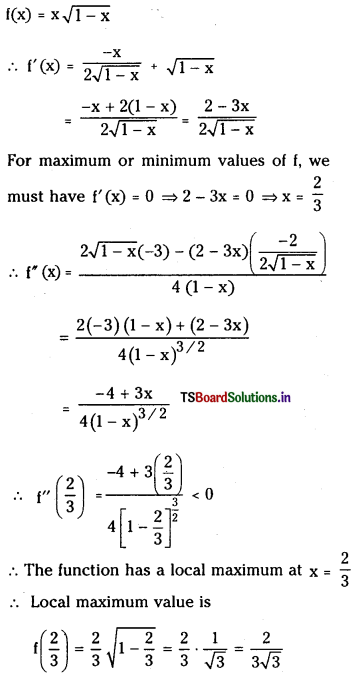
v) f(x) = \(\frac{1}{x^2+2}\), ∀ x ∈ R (S.A.Q)
Answer:
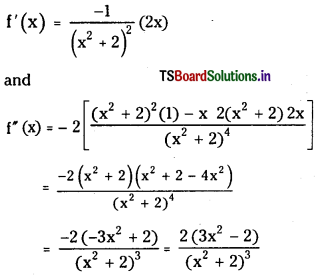
For maximum and minimum values of the function ‘f’ we have f’ (x) = 0
⇒ \(\frac{-2 x}{\left(x^2+2\right)^2}\) = 0 ⇒ x = 0
∴ f”(0) = \(\frac{2(0-2)}{(0+2)^3}=\frac{-1}{2}\) < 0
∴ f has maximum value at x = 0
and local maximum value at x = 0
∴ Local maximum value f(0) = \(\frac{1}{0^2+2}=\frac{1}{2}\)
![]()
vi) f(x) = x3 – 3x, ∀ x ∈ ℛ. (V.S.A.Q.)
Sol.
f'(x) = 3x2 – 3
For maximum and minimum values of f, we must have f’ (x) = 0
⇒ 3x2 – 3 = 0
⇒ x = ±1
f”(x) = 6x
At x = 1, f”(1) = 6 > 0
f has a local minimum at x = 1 and the minimum value is f(1) = 1 – 3 = – 2
At x = – 1 f”(- 1) = – 6 < 0
f has a local maximum at x = – 1
and the maximum value is f (- 1) = (- 1)3 – 3 (- 1) = 2
vii) f(x) = (x – 1) (x + 2)2 ∀ x ∈ ℛ. (S.A.Q.)
Answer:
f (x) = (x – 1) 2 (x + 2) + (x + 2)2
= (x + 2) [2x – 2 + x + 2]
= (x + 2) (3x)
f” (x) = (x + 2)3 + 3x = 6x + 6
For maximum and minimum values of f, we must have
f’ (x) = 0 => 3x (x + 2) = 0
⇒ x = 0 or x = -2
At x = 0, f’ (0) = 6 > 0 ; so the function f has minimum at x = 0
Minimum value of f is f(0) = (- 1) (2)2
= – 4
At x = – 2, f’ (-2) = – 12 + 6 = – 6 < 0
So f has maximum value at x = – 2
Maximum value of f is
f (-2) = (-2 – 1) (- 2 + 2)2 = 0
viii) f(x) = \(\frac{x}{2}+\frac{2}{x}\) ∀ x ∈ (0, ∞) (S.A)
Answer:
f ‘(x) = \(\frac{1}{2}-\frac{2}{x^2}\)
For maximum and minimum values of f, we must have
f'(x) = 0 ⇒ \(\frac{2}{x^2}=\frac{1}{2}\)
⇒ x2 = 4 ⇒ x = ±2
f”(x) = \(\frac{4}{x^3}\)
At x = 2, f”(2) = \(\frac{4}{8}=\frac{1}{2}\) >0
f has minimum value at x = 2
and minimum value of f is f (2) = \(\frac{2}{2}+\frac{2}{2}\) = 2
[At x = – 2, f”(- 2) = \(\frac{4}{-8}=\frac{-1}{2}\) < 0
f has maximum value at x = – 2
and maximum value of f at x = – 2 is
f(-2) = \(-\frac{2}{2}+\frac{2}{-2}\) = -2]
But we require the extremum in (0, °° )
Hence there exists only minimum value at x = 2 and minimum value is 2 only.
ix) f(x) = -(x – 1)3 (x + 1)2 ∀ x ∈ ℛ (E.Q.)
Answer:
Given f(x) = – (x – 1)3 (x + 1)2 ∀ x ∈ ℛ
f’ (x) = – [(x- 1)3 2(x + 1) + ( x + 1)2 3 (x – 1)2]
= – (x – 1)2 [2 (x2 – 1) + 3 (x2 + 2x + 1)]
= -(x – 1)2 [5x2 + 6x + 1]
= -(x – 1)2 [5x + 1] [x + 1]
= (x + 1) (x – 1)2 (- 1 – 5x)
f”(x) = (x + 1) (x – 1)2 (- 5) + (x – 12) (- 1 – 5x) = (x + 1) (- 1 – 5x) 2 (x – 1)
For maximum or minimum values of f,
we must have f’ (x) = 0 => x = – 1 or x = 1
or x = – 7
f “(1) = 0
∴ At x = 0, f has a critical value
f”(-1) =(1 + 1)2 (-1 + 5) = 4 (4) = 16 > 0
∴ f has minimum at x = – 1
∴ Minimum value of f is
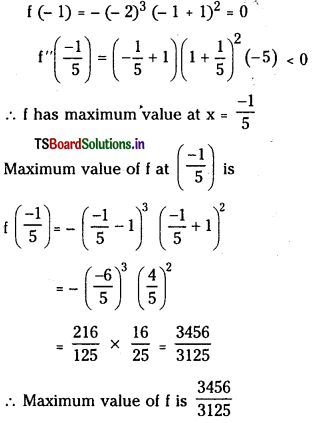
(x) f(x) = x2 e3x ∀ x ∈ ℛ. (S.A.Q.)
Answer:
f'(x) = 3x2 e3x + 2x e3x
= e3x(3x2 + 2x) . xe3x (3x + 2)
For maximum or minimum values f’(x) = 0
⇒ x = 0, x = \(\frac{-2}{3}\)
e3x = 0 solution is not feasible.
f”(x) = xe3x(3) + e3x(3x+2) + x(3x.2)3e3x
= e3x[3x + 3x + 2 + 3x (3x + 2)]
= e3x [9x2 + 12x + 2]
When x = 0 ⇒ f'(0) = 2 > 0
f has minimum value at x = 0 given by
f(0) = 0
when x = \(\frac{-2}{3}\) we have
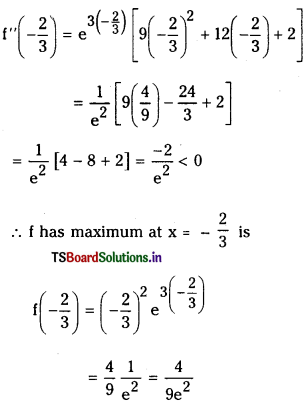
![]()
Question 2.
Prove that the following functions do not have absolute maximum and absolute minimum. (V.S.A.Q.)
(i) ex in ℛ.
Answer:
f(x) = ex and f'(x) = ex, f”(x) = ex
For maxima or minima, f'(x) = 0 ⇒ ex = 0
x value is not admissible.
∴ Hence f has no maxima or minima.
ii) log x in (0, ∞)
Answer:
Let f(x) = log x defined over (0, ∞)
Then f'(x) = \(\frac{1}{x}\) and f”(x) = \(\frac{-1}{x^2}\)
For maxima or minima,
f’ (x) = 0 ⇒ x value is not admissible
⇒ f(x) has no maxima or minima.
iii) x3 + x2 + x + 1 in ℛ.
Answer:
Let f (x) = x3 + x2 + x + 1
Then f'(x) = 3x2 + 2x + 1
f'(x) = 0 ⇒ 3x2 + 2x + 1 = 0
Since b2 – 4ac < 0 Equation has imaginary roots.
⇒ It has no maxima or minima.
II.
Question 1.
Find the absolute maximum value and absolute minimum value of the following functions on the domain specified against the function. (S.A.Q.)
i) f(x) = x3 on [-2, 2]
Answer:
The given function f(x) = x3 is continuous over [-2, 2]
f'(x) = 0 ⇒ 3x2 = 0 ⇒ x = 0;
so x = 0 is a minimum local point.
Local minimum value is ‘O’.
Hence out of f(-2), f(0), f(2)
i.e., – 8, 0, 8 the maximum value 8 is the
absolute maximum for ‘f
Similarly out of – 8, 0, 8, the absolute minimum is – 8.
ii) f(x) = (x – 1)2 + 3 on [-3, 1]
Answer:
f’ (x) = 2(x – 1) and f’ (x) = 2
f'(x) = 0 ⇒ x = 1 and f (1) = 2 > 0
Hence the minimum value is f(1) = 3
Similarly, f(-3) = (-3 – 1)2 + 3 = 16 + 3 = 19
∴ Absolute maximum value =19
Absolute minimum value = 3
iii) f(x) = 2|x| on [-1, 6]
Answer:
f’ (x) = \(\frac{2|\mathrm{x}|}{\mathrm{x}}\) and for max. or min. we have x
f’ (x) = 0 ⇒ |x| = 0 ⇒ x = 0 is a point of minimum
∴ f(0) = 0 is a minimum value.
Also f(- 1) = 2|(-1)| = 2 and
f(6) = 2|6| =12
∴ Absolute maximum value = 12
Absolute minimum value = 0
iv) f(x) = sin x + cos x on [ 0, π]
Answer:
We have f’ (x) = cos x – sin x
For maximum or minimum f'(x) = 0
⇒ cosx – sinx = 0
⇒ tan x = 1 ⇒ x = \(\frac{\pi}{4}\)
Also f”(x) = -sin x – cos x
and f”\(\left(\frac{\pi}{4}\right)\) = -sin\(\frac{\pi}{4}\) – cos\(\frac{\pi}{4}\)
= \(-\frac{2}{\sqrt{2}}\) = -√2 < 0
∴ f has maximum at x = \(\frac{\pi}{4}\) and
maximum value is f\(\left(\frac{\pi}{4}\right)\) = sin\(\frac{\pi}{4}\) + cos\(\frac{\pi}{4}\) = √2
Also f (0) = 1 and f (π) = – 1
∴ Absolute minimum value of f is – 1
Absolute maximum value of f is √2
v) f(x) = x + sin 2x on [0, π]
Answer:
f’ (x) = 1 + 2 cos 2x
and f”(x) = -4 sin2x
For maximum or minimum we have
f (x) = 0 ⇒ 1 + 2 cos 2x = 0
⇒ cos 2x = –\(\frac{1}{2}\)
⇒ 2x = 2nπ ± \(\frac{2 \pi}{3}\)
⇒ x = nπ ± \(\frac{\pi}{3}\)
The values of x lies in [0, π] are
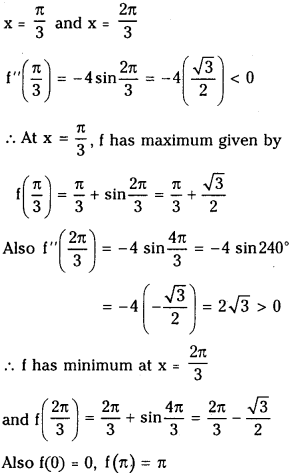
Out of all above values the absolute maximum value = \(\frac{\pi}{3}+\frac{\sqrt{3}}{2}\)
and absolute minimum value is \(\frac{2 \pi}{3}-\frac{\sqrt{3}}{2}\)
Question 2.
Use the first derivative test to find local extrema of f(x) = x3 – 12x on R. (S.A.Q.)
Answer:
If f is differentiable in (a, b) and c ∈ (a, b) is the local minimum or maximum of f then
f’ (c) = 0. This is the first derivative test.
f(x) = x3 – 12x
⇒ f'(x) = 3x2 – 12
f’ (x) = 6x ;
For max. or min. 3x2 – 12 = 0
⇒ x = ± 2
Consider [- 2, 2] for f(x) = x3 – 12x
f'(-2.1) = 3(-2.1)2 – 12 = 1.23 > 0
and f'(-1.9) = 3(-1.9)2 – 12 = -1.17 < 0
Derivative changes sign from positive to negative f” (-2) < 0.
Hence there exists maximum at – 2.
Max. value is f (- 2) = (- 2)3 – 12 (- 2)
= – 8 + 24 = 16
Similarly f (1.9) = – 1.17 < 0 and f (24) = 1.23 > 0
The derivative changes sign from negative to positive and f”(2) > 0.
Hence there exists minimum value at x = 2 and minimum value is f(2) = 8 – 24 = -16
∴ Local point of minimum is x = 2
Local minimum value is = – 16
Local point of maximum is x = – 2
Local maximum value is = 16
![]()
Question 3.
Use the first derivative test to find local extrema of f(x) = x2 – 6x + 8 on H. (S.A.Q.)
Answer:
Given f(x) = x2 – 6x + 8
f’ (x) = 2x – 6 and f” (x) = 2
Also f’ (x) = 0 ⇒ 2x – 6 = 0 ⇒ x = 3
Consider the behaviour of f’ (x) in the nbd of ‘3’.
When x = 2.9 we have f’ (2.9) = 2 (2.9) – 6
= 5.8 – 6 < 0 and when x = 3.1 we have f’ (3-1) = 2 (3.1) – 6 > 0
Hence derivative changes sign from
negative to positive and f”(x) > 0
∴ f has only local minimum at x = 3
and the local minimum value is f(3) = 32 – 6(3) + 8 = – 1
Question 4.
Use the second derivative test to find local extrema of the function f(x) = x3 – 9x2 – 48x + 72 on R.
Answer:
As per the second derivative test f is twice differentiable at ’c’ such that
i) f’ (c) = 0, f’ (c) < 0 theft f has maximum at ’c’ and maximum value is f(c).
ii) f’ (c) = 0, f’ (c) > 0 then f has minimum at ‘c’ and minimum value is f(c).
Given f(x) = x3 – 9x2 – 48x + 72
∴ f (x) = 3x2 – 18x – 48 = 3 (x2 – 6x – 16)
f'(x) = 0 ⇒ 3 (x – 8) (x + 2) = 0
⇒ stationary points are – 2 and 8.
f”(x) = 6x – 18 = 6(x – 3)
At x = – 2
f”(-2) = 6(-2 – 3) < 0
Hence f has maximum at x = – 2
and maximum value is f(- 2) = – 8 – 9 (- 2)2 – 48 (- 2) + 72
= -8-36 + 96 + 72
= 124
Also f”(8) =6 (8 – 3) = 30 > 0
Hence f has minimum at x = 8 and
minimum value is
f(8) = 83 – 9(8)2 – 48 (8) + 72
= 512 – 576 – 384 + 72 = – 376
∴ Local minimum = – 376
Local maximum = 124
Question 5.
Use the second derivative test to find the local extrema of the function f(x) = – x3 + 12x2 – 5 on ℛ. (S.A.Q.)
Answer:
Let f(x) = – x3 + 12x2 – 5
Then for max. or min. we must have f'(x) – 0
⇒ – 3x2 + 24x = 0
⇒ – 3x (x – 8) = 0
So the stationary points are x = 0, x = 8
f”(x) = -6x + 24
∴ f”(0) = 24 > 0,
Hence f has a minimum at x = 0 .
and minimum value is f(0) = – 5
Also f”(8) = -48 + 24 = -24 < 0,
Hence f has a maximum at x = 8
Maximum value is f(8) = – 83 + 12 (8)2 – 5
= – 512 + 768 – 5
= 251
∴ Local minimum = – 5
Local maximum = 251
Question 6.
Find the local maximum or local minimum of f(x) = -sin 2x – x defined on \(\left[-\frac{\pi}{2}, \frac{\pi}{2}\right]\) (S.A.Q)
Answer:
f(x) = – sin 2x – x defined on \(\left[-\frac{\pi}{2}, \frac{\pi}{2}\right]\)
f’ (x) = -2 cos 2x – 1
and f’ (x) = 4 sin 2x
For maximum or minimum values,
f’ (x) = 0 ⇒ 2 cos 2x + 1 = 0
⇒ cos 2x = –\(\frac{1}{2}\)
⇒ 2x = 2nπ ± \(\frac{2 \pi}{3}\)
⇒ x = nπ ± \(\frac{\pi}{3}\)
Values of x to be considered in \(\left[-\frac{\pi}{2}, \frac{\pi}{2}\right]\) are \(\frac{\pi}{3}\) and –\(\frac{\pi}{3}\) respectively
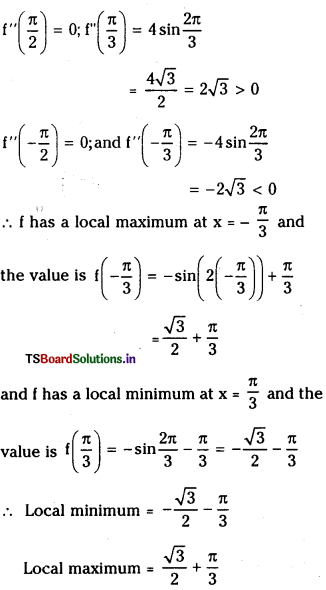
![]()
Question 7.
Find the absolute maximum and absolute minimum of f(x) = 2x3 – 3x2 – 36x + 2 on the interval [0, 5]. (S.A.Q.)
Answer:
Given f(x) = 2x3 – 3x2 – 36x + 2
We have f’ (x) = 6x2 – 6x – 36 and f’ (x) = 12x – 6
f'(x) = 0 ⇒ 6x2 – 6x – 36 = 0
⇒ x2 – x – 6 = 0
⇒ (x – 3) (x + 2) = 0
Stationary values of f are – 2 and 3.
The value x = – 2 is not admissible since -2 ∉ [0, 5]
At x = 0, we have f”(0) = -6 < 0 At x = 5, we have f “(5) = 12 (5) – 6 = 54 > 0
At x = 3 we have f”(3) = 12 (3) – 6 = 30 > 0
The absolute maximum value of f is f(0) = 2
and absolute minimum value out of minimum values is – 79
[f(3) = 2 (3)3 – 3 (3)2 – 36 (3) + 2
= 54 – 27 – 108 + 2 = – 79
f(5) = 2 (5)3 – 3 (5)2 – 36 (5) + 2 = – 3]
∴ Absolute minimum = – 79
Absolute maximum = 2
Question 8.
Find the absolute extremum of
f(x) = 4x – \(\frac{x^2}{2}\) on [-2, \(\frac{9}{2}\)] (S.A.Q)
Answer:
f(x) = 4x – \(\frac{x^2}{2}\)
f (x) = 4 – \(\frac{2 x}{2}\)
For extremum we have
4 – x = 0 ⇒ x = 4
f”(x) = -1 < 0
f has maximum value at x = 4
1(4) = 16 – \(\frac{16}{2}\) = 8
-2 ≤ x ≤ \(\frac{9}{2}\) we have
f (- 2) = – 8 – 2 = – 10
Absolute minimum = – 10
and Absolute maximum = 8
Question 9.
Find the maximum profit that a company can make if the profit function is given by P(x) = -41 + 72x – 18x2. (S.A.Q.)
P(x) = -41 + 72x – 18x2
Answer:
P'(x)= 0 ⇒ 72 – 36x = 0 ⇒ x = 2
Since P”(x) = – 36 < 0
P(x) has maximum
for x = 2 and the maximum profit
P(2) = – 41 + 72 (2) – 18(4)
= – 41 + 144 – 72 = 31
Question 10.
The profit function P(x) of a company selling x items is given by P(x) = – x3 + 9x2 – 15x – 13 where x represents thousands of units. Find the absolute maximum profit if the company can manufacture a maximum of 6000 units. (S.A.Q.)
Answer:
P(x) = – x3 + 9x2 – 15x – 13 and p’ (x) = – 3x2 + 18x – 15
For maximum or minimum p’ (x) = 0
⇒ – 3x2 + 18x- 15 = 0
⇒ x2 – 6x + 5 = 0
⇒ (x – 5) (x – 1) = 0
⇒ x = 1, 5
Also p”(x) = -6x + 18
P”(1) = 12 >0, P”(5) = -12 < 0
P(x) has maximum when x = 5
and maximum profit is P(5) = – 53 + 9(5)2 – 15 (5) – 13
= -125 + 225 – 75 – 13 = 12
∴ Maximum profit = 12
III.
Question 1.
The profit function P(x) of a company selling x items per day is given by P(x) = (150 – x) x – 1000. Find the number of items that the company should manufac-ture to get maximum profit. Also find the maximum profit. (E.Q.)
Answer:
Given that the profit function is
P(x) = (150 – x) x – 1000
For extremum, we have p’ (x) = 0
⇒ 150 – 2x = 0 ⇒ x = 75
P”(x) = – 2 < 0 ;
P(x) has maximum at x = 75
∴ The profit is maximum for x = 75
The number of items that the company should manufacture to get maximum profit = 75 and the maximum profit = (150 – 75)75 – 1000 = 4625
Question 2.
Find the absolute maximum and absolute minimum of f(x) = 8x3 + 81x2 – 42x – 8 on [- 8, 2]. (E.Q.)
Answer:
Given f(x) = 8x3 + 81x2 – 42x – 8 on [ – 8, 2]
For extrema we have f'(x) = 0
⇒ 24x2 + 162x – 42 = 0
⇒ 4x2 + 27x – 7 = 0
⇒ 4x2 + 28x – x – 7 = 0
⇒ 4x(x + 7)-l(x + 7) = 0
⇒ (4x – 1) (x + 7) = 0
⇒ x = – or x = – 7
f'(x) = 48x + 162
f”\(\left(\frac{1}{4}\right)\) = 48\(\left(\frac{1}{4}\right)\) + 162 = 12 + 162 = 174 > 0
f has a minimum at x = \(\frac{1}{4}\)
Minimum value is
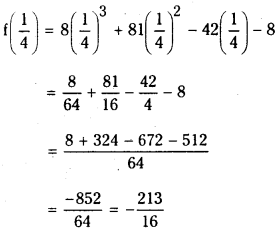
![]()
Question 3.
Find two positive integers whose sum is 16 and the sum of whose squares is minimum. (E.Q.)
Answer:
Suppose x and y are two positive integers and given that
x + y = 16 and x2 + y2 = f(x, y) is to be minimised,
f (x, y) = x2 + y2
⇒ f(x) = x2 + (16 – x)2
For extremum we have f'(x) = 0
⇒ 2x – 2(16 – x) = 0
⇒ x – 16 + x = 0
⇒ 2x- 16 = 0
⇒ x = 8
Since f”(8) = 4 > 0
f(x) has minimum at x = 8
∴ y = 16 – x = 16 – 8 = 8
∴ The two positive integers are 8 and 8
Question 4.
Find two positive integers x and y such that x + y = 60 and xy3 is maximum. (E.Q.) (May 2014)
Answer:
Given x + y = 60
⇒ y = 60 – x (1)
and f(x, y) = xy3
f(x) = x (60 – x)3 …………..(2)
For extrema, f’ (x) = 0
⇒ x(3) (60 – x)2 (-1) + (60 – x)3
= (60 – x)2 [60 – x – 3x]
= (60 – x)2 (60 – 4x)
x = 60 and x = 15
x = 60 is not admissible. So we take x = 15
r (x) = (60 – x)2 (- 4) + (60 – 4x) 2 (60 – x) (- 1)
and f” (15) < 0
∴ f has maximum at x = 15
∴ From (1) y = 45
The required two positive integers are x = 15 and y = 45.
Question 5.
From a rectangular sheet of dimensions 30 cm x 80 cm four equal squares of side x cm are removed at the corners and the sides are then turned up so as to form an open rectangular box. Find the value of x so that the volume of the box is the greatest. (March 2014) (E.Q.)
Answer:
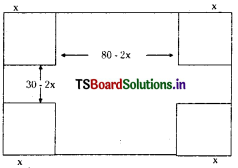
Length of the box = 80 – 2x = l
Breadth of the box = 30 – 2x = b
Height of the box = x = h
Volume of the box V = lbh
∴ f(x) = (80 – 2x) (30 – 2x) x
= x (2400 – 220 x + 4x2)
= 4x3 – 220 x2 + 2400 x
∴ f'(x) = 12x2 – 440 x + 2400
= 4[3x2 – 110x + 600]
∴ f'(x) = 0 ⇒ 3x2 – 110x + 600
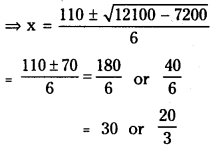
When x = 30, then f”(x) = 24x – 440
and f”(30) = 24 × 30 – 440
= 720 – 440 = 280 > 0
∴ f has a minimum or least at x = 30
When x = \(\frac{20}{3}\) then
f”\(\left(\frac{20}{3}\right)\) = 24\(\left(\frac{20}{3}\right)\) – 440 = 160 – 440 = -280 < 0
f has maximum at x = \(\frac{20}{3}\)
In order the volume of the box is the greatest the value of x must be \(\frac{20}{3}\)cm.
Question 6.
A window is in the shape of a rectangle surrounded by a semicircle. If the perimeter of the window is 20 feet, find the maximum area. (E.Q.)
Answer:
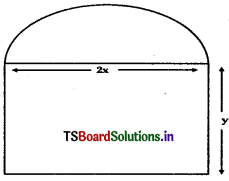
Let the length of the window be 2x and breadth be y so that the radius of the semicircle is x
∴ Perimeter = 2x + 2y + π. x = 20
⇒ 2y = 20 – 2x – πx
∴ y = 10 – x – \(\frac{\pi x}{2}\)
Area = 2xy + \(\frac{\pi}{2}\) x2
f(x) = x (20 – 2x – 7ix) + \(\frac{\pi}{2}\) x2
⇒ f'(x) = x (- 2 – π) + (20 – 2x – πx) + πx
= – 2x + 20 – 2x – πx = 20 – 4x – πx
For maximum or minimum f'(x) = 0
⇒ 20 – (4 + π)x = 0
⇒ x = \(\frac{20}{\pi+4}\)
f” (x) = – 4 – π < 0
⇒ f has maximum at x = \(\frac{20}{\pi+4}\)
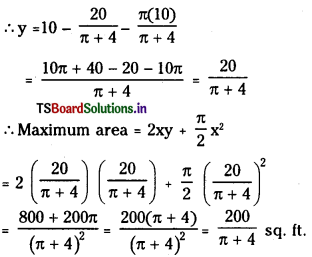
Question 7.
If the curved surface of a right circular cylinder inscribed in a sphere of radius r is maximum, show that the height of the cyliner is √2r. (IPE May ’11 Mar. 13, ’08, 04, June 2004)
Answer:
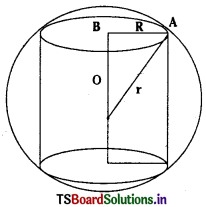
Let the radius of the cylinder be R’ and height be ‘h’
From ΔOAB we have
OA2 = AB2 + OB2
⇒ r2 = R2 + \(\frac{h^2}{4}\)
⇒ R2 = r2 – \(\frac{h^2}{4}\)
Curved surface area = 2πrh
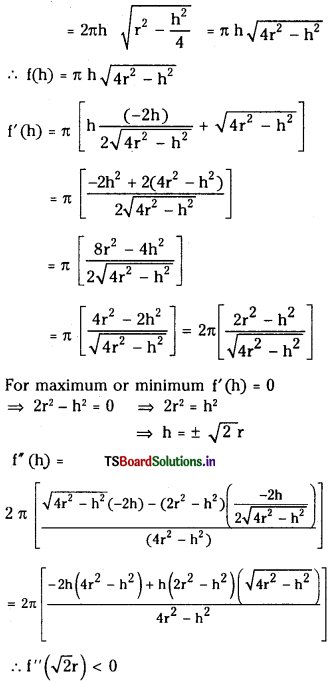
Hence f has maximum at h = √2r
Height of the cylinder = √2r
![]()
Question 8.
A wire of length l is cut into two parts which are bent respectively in the form of a square and a circle. What are the lengths of the pieces of the wire respectively so that the sum of the areas is the least ? (E.Q) (BIE New Model Paper)
Answer:
Let x be the side of the square and r be the radius of the circle.
Given 4x + 2π r = l
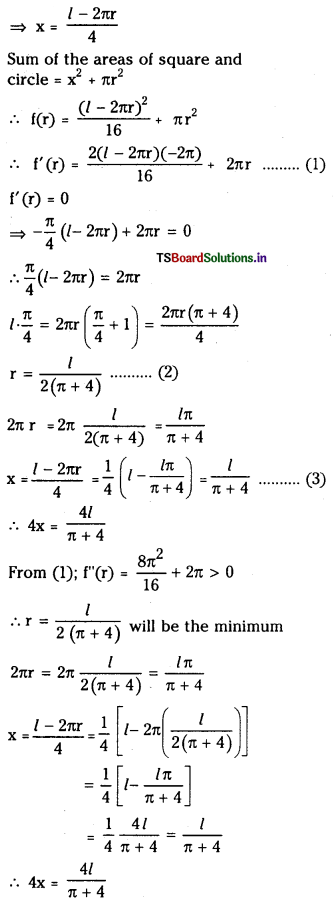
So when the wire is cut into two pieces, Sum of the areas of square and circle will be the least and their lengths are
\(\frac{\pi l}{\pi+4}\) and \(\frac{4 l}{\pi+4}\) respectively.